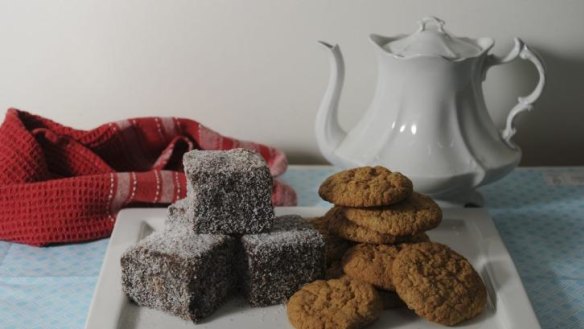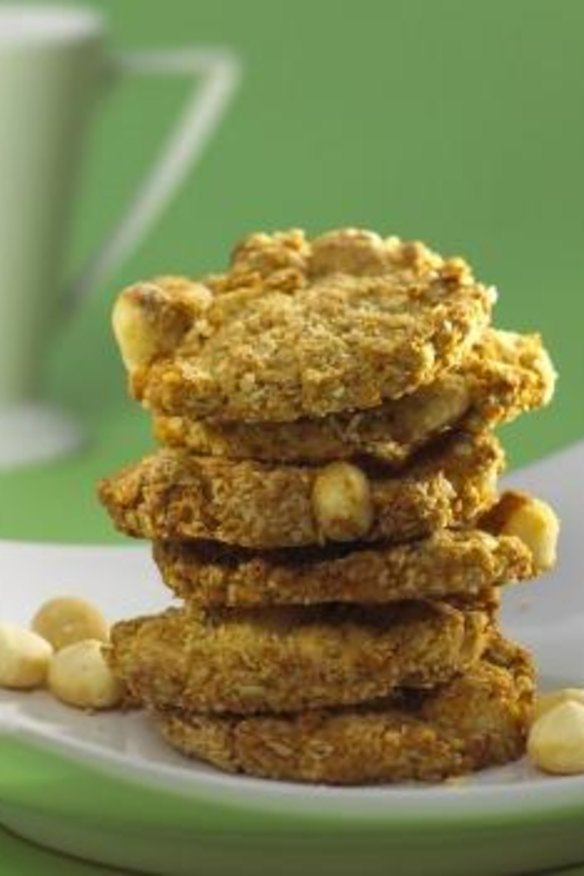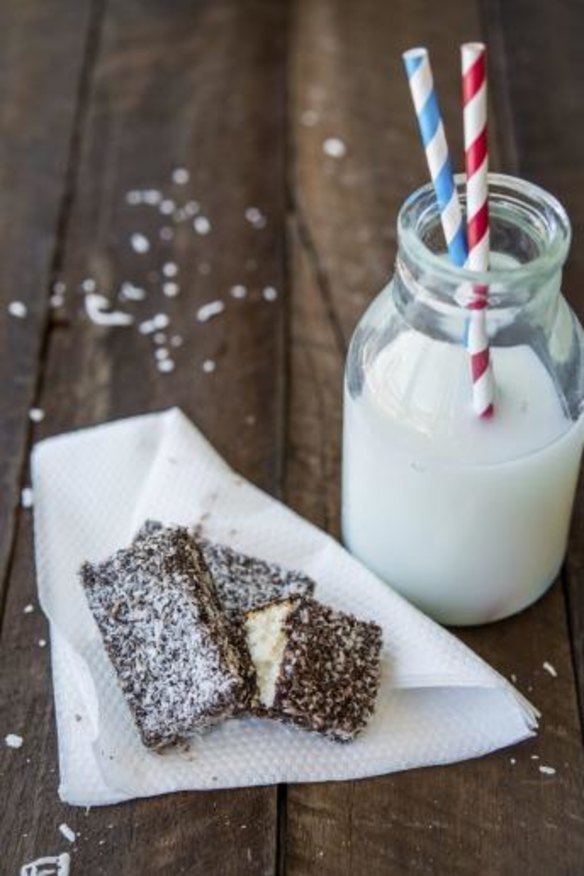Royal Canberra Show 2015: Anzacs, lamingtons and damper for Gallipoli tribute

Crack your tea towels and unholster your rolling pins; this year the Royal Canberra Show is all about the food of the diggers. In addition to the tea cakes, scones, marble cake and sponge rolls, this year the bakers at the show will get to make Anzac classics in a special category that commemorates the centenary of Gallipolli.
'Commemorating the Gallipoli Diggers' is the new category in this year's show, and it features a trio of Australian classics, Anzac biscuits, lamingtons and a piece of damper. So we spoke to contestants, judges, and the Country Women's Association to bring you the best of traditional Australian baking.
Anzac biscuits are an essential and very tasty part of Australian history. During the First World War, Australians at home wanted something to send to soldiers abroad. Wives, girlfriends, sisters and mothers looked for something sweet that wouldn't spoil, wasn't expensive, and didn't use eggs due to shortages. The original Anzac recipe was based on Scottish oat cakes – it was nutritious, used treacle or golden syrup as a binding agent, and would last the two-month shipping time to reach the troops.

Libby Bailey, a competitor at the past six shows, says Anzac biscuits can be extremely temperamental. "I have real difficulty with Anzacs, they tend to either crack people's crowns or crumble away," she says.
The basic elements of the Anzac are simple: flour, oats, sugar, butter, coconut, bi-carb and a dash of golden syrup or treacle. The hardest part is simply pleasing people: personal taste is key, and people are very finicky. Some people insist on a hard, crunchy biscuit that snaps cleanly down the middle. Others prefer a chewy biscuit with strong caramel tones. It all depends on the ratio of sugar to golden syrup – adding more sugar gives you a crunchier biscuit and more golden syrup produces a softer, chewy version. Cooks can also get similar effects experimenting with oven times, such as comparing results from a hotter oven for a short period of time to a low oven for longer. "But remember to watch them like a hawk, or the neighbours will be sending in the fire brigade," Bailey says.
There's no shortage of tips for those thinking of whipping up a batch of biscuits. Thankfully with Anzacs, a delicious biscuit doesn't need any expensive ingredients. Cooks can give stone ground flour a miss, and while organic oats might be necessary for a race horse, they aren't needed for a good biscuit. "I just use plain, ordinary, no name ingredients," Bailey says. But she does recommend that you check the freshness of your baking soda. It's a quick test; simply add a spoon full of baking soda to hot water. If it fizzes, it's fresh, and if it doesn't, it's time to retire that batch for cleaning purposes.

Presentation and consistency are key to a successful outing at the Canberra show. So measure the dough when putting biscuits in to bake. Popping a tea towel on the drying rack can also prevent rack marks on cakes and biscuits. Competition cooking brings added challenges, as biscuits have to be a consistent size, shape, texture and colour. State judge Barbara Skein says the ladies of the CWA value excellence in traditional cooking when it comes to Anzacs. "They are fairly simple. They should be uniform, thin, and should break clean in half when you snap them, with a nice golden colour," she says. "And I think if we're looking at the Anzac year, we should be looking at what they ate then." This means omitting raisins, ginger and other spices. Stick to the basics if you want to bake a winning batch and leave your experimental ingredients at home.
And despite the fact that biscuits would be more than two months old by the time they reached the Anzacs, Skein doesn't recommend that anyone goes to that length. Eat them fresh out of the oven if you're playing at home.
Lamingtons are the second challenge in the Gallipoli category. Their origins are attributed to Lord Lamington, a governor of Queensland in the late 19th
There are many varieties of lamington; they come with jam, lemon and even rum in Cleveland, of all places. Of course, the Canberra show values traditional recipes, so entrants might want to stick to a traditional butter cake base, with no jam or cream. "I've got a handwritten, well-loved and well-worn recipe, I learnt from my mum and my grandmother as a child," says Kirsty Reiter, a CWA member planning to enter this year. "Keep it simple, and don't mess with tradition," she says.
Lamingtons aren't often entered in competitions, but they're the trickiest part of the new category. It all starts with a good quality butter cake, Reiter says. "Know your oven, cream your butter and sugar well, and remember, making [lamingtons] is a messy process, embrace it. It's all about the eggs – mine come from the backyard chooks."
Skein agrees, adding that popping the cake in the freezer for an hour before icing can help with presentation. "We're looking for uniform size, coconut should be white, and when cut, the coating must not have penetrated the cake," she says. "Competition cooking is very different to what you cook for your family. Food for them is gone in half an hour."
If you're looking to use a sponge cake as a base, make sure to mix it carefully, says the show's chief steward Chris Tarlinton. "Never beat a sponge, always fold it carefully," she says. And then watch it rise.
Entries to the Gallipolli Diggers category at the Royal Canberra Show should include six Anzac biscuits, six lamingtons and one plain damper. First prize is $100 and a champion's ribbon, second prize $50, third $35 and the fourth prize is $15. Entries close on February 13. The Royal Canberra Show runs from February 27 to March 1.
Anzac biscuits
1 cup plain flour
1 cup sugar
1 cup rolled oats
1 cup desiccated coconut
125g butter
1 tbsp golden syrup or treacle
2 tbsp boiling water
1 tsp bicarb soda
Preheat the oven to 180°C and lightly grease two baking trays. Combine the flour in a bowl with the sugar, rolled oats and coconut. Melt the butter in a saucepan with the golden syrup over medium heat. Combine the boiling water with the bicarb soda and stir to dissolve. Add the butter mixture and mix well, then stir into the dry ingredients until thoroughly combined. Drop teaspoons of the mixture onto the trays, allowing room for spreading. Bake for 10 minutes, or until golden brown. Allow to cool on the tray for a few minutes before transferring to a wire rack to cool completely.
Lamingtons
For the butter cake
140g butter
140g sugar
2 eggs
4 tbsp milk
¼ tsp vanilla essence
270g sifted plain flour,
For the icing
85g butter
215g icing sugar
1 tbsp cocoa powder
Hot water
Desiccated coconut
Cake
Preheat the oven to 180°C and grease a rectangular cake tin. Cream the butter and sugar in a bowl. Add the eggs, milk and vanilla essence, and finally the flour. Pour the mixture into the tin and bake for 30 minutes. Turn out onto a wire rack to cool, and leave until the next day, when it should be cut into squares.
Icing
Cream the butter and icing sugar together. Mix the cocoa powder with a little hot water and add to the butter mixture, and stir in the vanilla essence. Take care not to add too much hot water, as this will make the icing too thin. Ice the cake squares all over, and roll them in the coconut. Optionally, you can brown the coconut in a shallow baking tin in a 150°C oven for a few minutes.
Restaurant reviews, news and the hottest openings served to your inbox.
Sign up